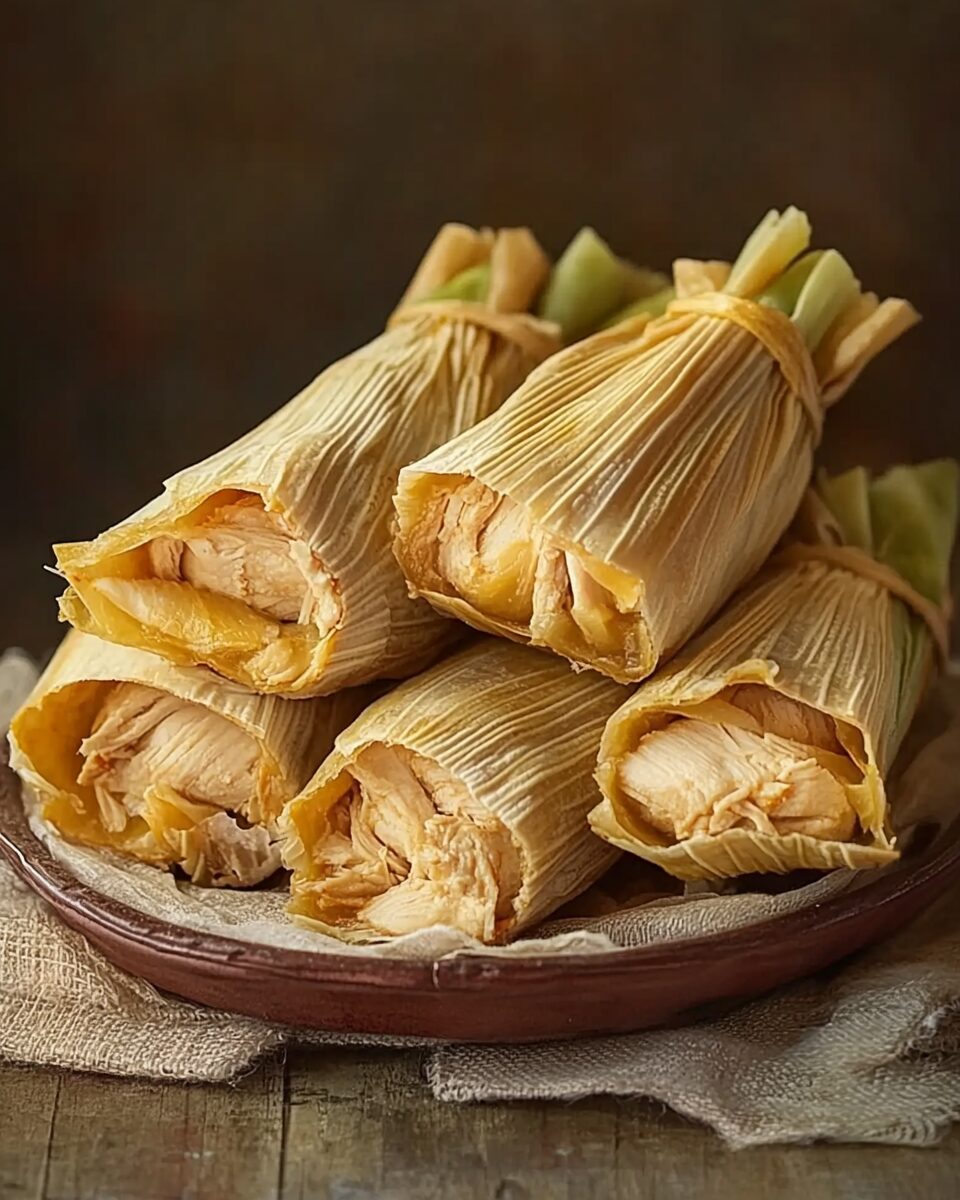The rich, savory filling of shredded rotisserie chicken, vibrant green peas, and pimiento-stuffed olives wrapped in tender corn husks brings bold flavors and comfort to the table. Perfectly seasoned with green salsa and melted cheese, these tamales are a weeknight-friendly take on a beloved Latin American classic.
They’re easy to prepare, using clever shortcuts like pre-cooked chicken and self-rising cornmeal. Steam them up in just 25 minutes, and you’ve got a steamy, satisfying dinner that feels both traditional and modern. Pair with refried beans, a fresh salad, or crema for a complete meal that will have everyone asking for seconds.
Full Recipe:
-
14 large corn husks (soaked in warm water until pliable)
-
1 rotisserie chicken (2-3 pounds), skin removed and shredded (about 6 cups)
-
1 cup shredded Mexican-blend cheese
-
1/2 cup chopped fresh cilantro, plus extra for garnish
-
1/2 cup frozen green peas
-
1/2 cup pimiento-stuffed green olives, halved
-
2 cups bottled green salsa
-
2 cups self-rising yellow cornmeal mix
Directions:
-
Soak the corn husks in warm water for 30 minutes or until softened.
-
In a large bowl, mix shredded chicken, cheese, cilantro, peas, olives, and salsa. Stir in the cornmeal mix until fully combined.
-
Tear 2 soaked husks into 12 thin strips to use as ties.
-
Lay one husk on a flat surface with the wide end at the top. Spoon about 2/3 cup of the filling down the center and form into a 4×2-inch rectangle.
-
Roll the husk jelly roll-style to enclose the filling. Fold the bottom up and tie with a strip. Repeat with remaining husks and filling.
-
Place a steamer basket in a deep pot with about 1 inch of water. Stand tamales upright (folded end down) in the basket.
-
Bring to a boil, cover, and steam for 25 minutes. Add water as needed to maintain steaming.
-
Remove from heat and let tamales stand for 5 minutes before serving. Unwrap and garnish with chopped cilantro.
Prep Time: 10 minutes | Cooking Time: 25 minutes | Total Time: 1 hour 10 minutes (including inactive soaking time)
Kcal: Approx. 325 kcal per serving | Servings: 12
Introduction to Chicken Tamales: A Celebration of Flavor and Tradition
Chicken tamales are a delicious fusion of culture, history, and culinary comfort. Rooted in ancient Mesoamerican tradition, tamales have been passed down through generations, evolving into a dish that’s now enjoyed across Latin America and beyond. This particular Chicken Tamales recipe by Ingrid Hoffmann, featured on the Food Network, offers a simplified yet flavor-packed version that brings tradition to the table with a modern, weeknight-friendly twist.
While traditional tamales can take hours or even days to prepare—complete with homemade masa, rich sauces, and a slow-cooked meat filling—this version is designed for busy home cooks who still want to enjoy the soulful experience of tamale making. By incorporating rotisserie chicken and self-rising cornmeal mix, Hoffmann provides a streamlined alternative that doesn’t compromise on taste or authenticity.
A Culinary Shortcut Without Sacrificing Soul
What makes this tamale recipe stand out is its accessibility. Tamales are often associated with labor-intensive cooking processes that require significant time, specialized ingredients, and often, the helping hands of an entire family. Hoffmann’s recipe reimagines this classic with readily available grocery store staples like rotisserie chicken, jarred green salsa, and pre-mixed cornmeal. These substitutions cut prep time dramatically while preserving the integrity of the dish.
Despite these shortcuts, the final result remains deeply satisfying. The tamales boast a flavorful and moist filling infused with cheese, cilantro, green peas, and green olives—an unconventional yet flavorful blend that adds layers of taste and texture. It’s a great example of how tamales can be versatile and open to personalization, all while maintaining the heart and soul of the original.
A Texture and Flavor Symphony in Every Bite
One of the standout qualities of these chicken tamales is the interplay of textures and tastes. The shredded rotisserie chicken offers a tender, juicy protein base, while the melted Mexican-blend cheese brings in a creamy, slightly tangy richness. The peas and olives add pops of sweetness and briny depth respectively, creating a balance that dances across the palate.
The green salsa, often overlooked as a simple topping, becomes a star in this dish, infusing the filling with a zesty heat and herbaceous lift. When wrapped in corn husks and steamed, all these flavors meld beautifully within the cornmeal dough, producing tamales that are moist, aromatic, and comforting.
Why Corn Husks Matter
Tamales wouldn’t be tamales without the iconic corn husk wrapper. More than just a vessel, corn husks provide a natural steaming container that adds a subtle earthiness to the dish. They also serve an aesthetic and functional role—holding the tamale together while it cooks and giving the final presentation a rustic, handmade appeal.
In this recipe, Hoffmann takes care to include instructions for soaking the husks until pliable, a crucial step for easy folding and tying. The corn husks also make the dish feel more traditional, reinforcing the authenticity that home cooks crave even when using convenient ingredients.
Simplified Tamale Assembly for All Skill Levels
While traditional tamale-making can be daunting for first-timers, this recipe breaks the process down into manageable steps, making it ideal for those new to the art. Instead of spreading masa on the husks and adding a separate filling, everything is mixed together beforehand—resulting in a filling that is ready to spoon and roll. This technique eliminates the common fear of uneven filling or torn husks, and it empowers even beginner cooks to try their hand at tamales without intimidation.
This method also allows the tamales to hold together better during the steaming process. They cook uniformly and unwrap beautifully, making them ideal for entertaining or for prepping ahead and reheating later.
Perfect for Parties and Gatherings
Tamales are inherently communal food. Whether served during holidays like Christmas or Cinco de Mayo, or at family reunions and potlucks, they are designed to feed a crowd. This recipe yields 12 hearty tamales, making it perfect for sharing. It also scales easily—double or triple the batch and you’ve got an instant party menu.
Because they are individually wrapped, tamales are also ideal for serving buffet-style. Guests can pick up a tamale, top it with extra salsa, sour cream, or guacamole, and enjoy it without needing plates or utensils. It’s a tactile, flavorful experience that feels celebratory in every bite.
A Nutritional Perspective
From a nutritional standpoint, these tamales strike a balance between indulgent and wholesome. Using rotisserie chicken reduces the need for added fats, while the inclusion of peas and cilantro adds a touch of fiber, antioxidants, and vibrant green color. While cheese and olives do introduce some salt and fat, the portion control inherent in tamale wrapping helps moderate intake.
The self-rising cornmeal mix simplifies preparation while also offering a source of complex carbohydrates. Additionally, the steaming method means there’s no need for oil or frying, making this a relatively low-fat way to enjoy a deeply satisfying meal.
Cultural Connection with a Modern Twist
While purists might argue that tamales should be made the traditional way—using masa harina and lard—Hoffmann’s recipe acknowledges the reality of modern life. Not everyone has the time, tools, or know-how to make tamales from scratch, but that doesn’t mean they should miss out on this comforting and culturally rich dish.
Ingrid Hoffmann’s take on chicken tamales embraces flexibility and ease, encouraging more people to experience this cornerstone of Latin cuisine. Her version also invites personalization. Don’t like olives? Swap them for jalapeños or roasted corn. Want more spice? Choose a hotter salsa or add chili flakes. The possibilities are endless.
A Great Way to Introduce Latin Cuisine to New Cooks
For those unfamiliar with Latin cuisine, this chicken tamale recipe is an approachable entry point. It uses familiar ingredients and simple techniques, making it perfect for international food nights, cooking with kids, or exploring new culinary traditions.
It also creates an opportunity for dialogue around culture, heritage, and food traditions. Sharing these stories over a plate of tamales can foster connection, appreciation, and the joy of discovering something new together.
Storage and Leftovers Made Easy
Another advantage of this recipe is how well the tamales store. Once cooked, they can be refrigerated for up to five days or frozen for several months. Reheating is as simple as steaming again or popping them into the microwave with a damp paper towel to retain moisture. This makes them an excellent option for meal prepping or planning ahead for busy weeknights.
Freezing tamales also means you can make a large batch and have homemade meals ready whenever you crave something comforting and warm. Just remember to wrap them tightly to avoid freezer burn and maintain flavor integrity.
Conclusion: Chicken Tamales for the Modern Cook
Ingrid Hoffmann’s Chicken Tamales recipe is more than a dish—it’s a culinary bridge between tradition and modern convenience. It captures the essence of tamales—the warmth, the celebration, the heritage—while eliminating the barriers that often keep home cooks from attempting them.
Whether you’re cooking for a holiday gathering or a cozy weeknight meal, this recipe offers the perfect blend of flavor, simplicity, and tradition. It invites cooks of all skill levels to explore Latin American cuisine and brings people together around the table, one steamy, savory tamale at a time.
From its accessible ingredients to its foolproof preparation, this dish proves that you don’t need to spend hours in the kitchen to create something special. With every bite, you’re tasting culture, comfort, and the joy of cooking made just a little easier.





